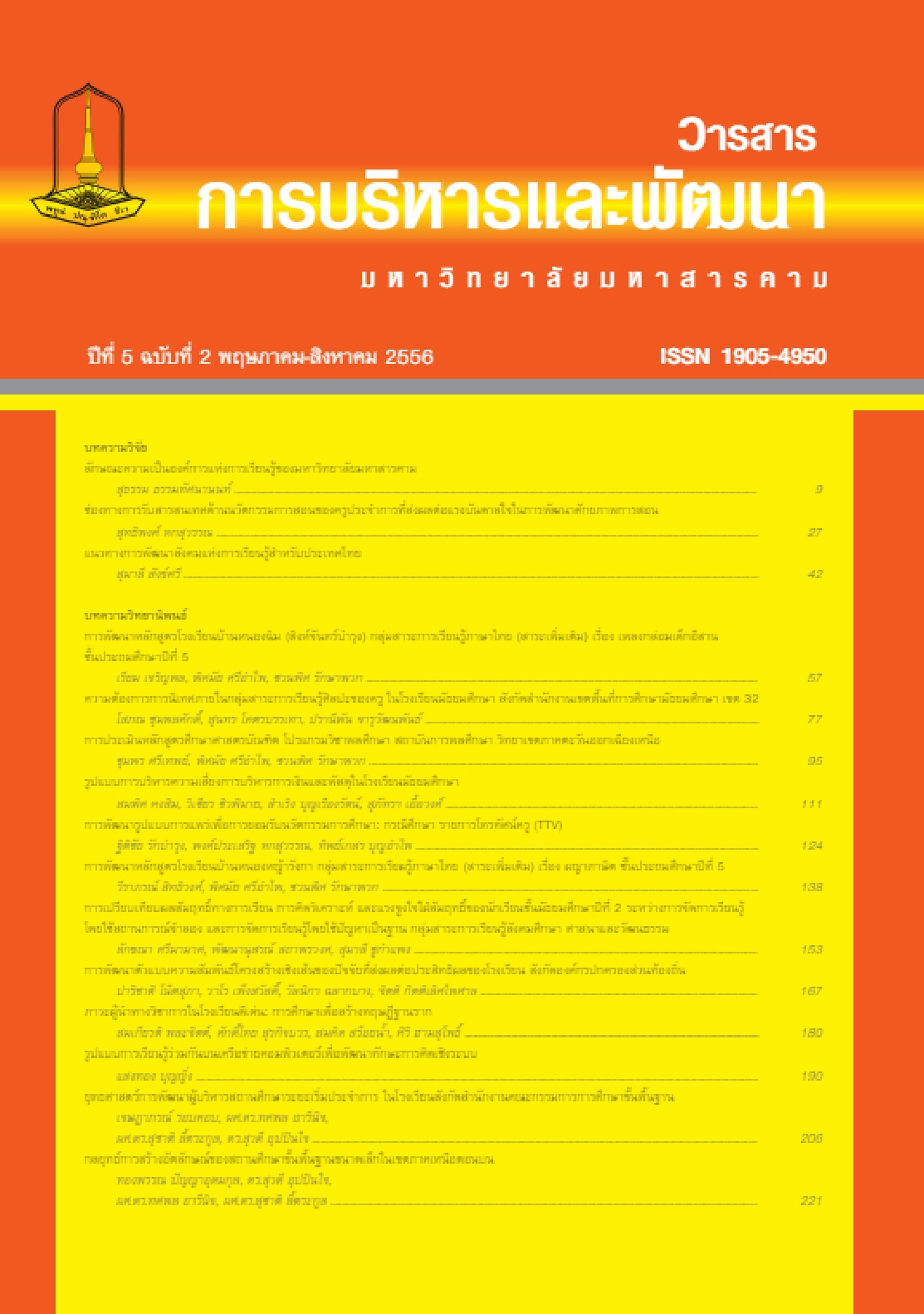The Development of Thai Substance Group Curriculum (additional supplement) on the Topic of Phayapasit for Prathomsuksa 5, Ban Nongyarangka School
Main Article Content
Abstract
The development of school curriculum needs to meet local needs and provide the communities a chance to participate in identifying curriculum so that the curriculum varies. The communities should also take part in organizing learning activities which are consistent with the needs of communities and learners. The purposes of this research study were: 1) to survey the needs in developing school curriculum; 2) to develop the school curriculum that has quality at the “highly appropriate” level onward; 3) to try out the implementation and find out efficiency of school curriculum; and 4) to evaluate the use of school curriculum. The research sample was composed of 20 Prathom Suksa 5 students attending Ban Nongyarunga School in the second semester of the academic year 2011. The research instruments consisted of: 1) curriculum’s supplementary document on the topic of Proverb Phaya; 2) nine instructional plans with the highest level of quality ( = 4.71, S.D. = 0.26; 3) a 30-itemed multiple-choice (four choices) learning achievement test with the itemized discriminating powers ranging .20 to .58 and the reliability of .87; 4) a 20-itemed 5-rating-scaled questionnaire asking students’ opinions on learning that used school curriculum with the itemized discriminating powers ranging .47 to .89 and the reliability of .96; and 5) a 30-itemed 5-rating-scaled questionnaire asking teachers’ opinions with the itemized discriminating powers ranging .27 to .97 and the reliability of .98. The analysis of data employed Mean, Standard Deviation, and percentage.
Findings were as follows:1. Surveying the needs of students, teachers, parents, school committee, and local wisdoms revealed the needs to develop Ban Nongyarunga School curriculum, Thai language substance group (additional supplement), on the topic of Proverb Phaya, Prathom Suksa 5. The development should bring local wisdoms to take part in the process of conveying knowledge to learners.
2. The school curriculum development and evaluation revealed the complete elements at the “most appropriate” level ( = 4.76, S.D. = 0.26). Learning plans accompanied the curriculum including concepts, learning standards/indicators, expected learning outcomes, learning objectives, learning contents, learning materials and resources, desired characteristics, measurement and evaluation, and learning process were at the “most appropriate” level ( = 4.71, S.D. = 0.26).
3. Trying out the implementation and finding out efficiency of Ban Nongyarunga School curriculum, Thai language substance group (additional supplement), on the topic of Proverb Phaya, Prathom Suksa 5 revealed the efficiency of 83.00/84.67 and the effectiveness index was at 0.6085 which indicates that students gained 60.85% in learning.
4. The evaluation of students’ opinions on organization of learning that used school curriculum resulted the “highly agree” level (x̅ = 4.79, S.D. = 0.41) and the evaluation of opinions of teachers who implemented the curriculum resulted the “highly appropriate” level ( x̅ = 4.69, S.D. = 0.25). In conclusion, Ban Nongyarunga School curriculum, Thai language substance group (additional supplement), on the topic of Proverb Phaya, Prathom Suksa
5 which was developed by research and development was consistent with the needs of learners and local communities as it was developed from participation of related persons. It was also the curriculum that had complete and harmonious elements evaluated by groups of experts. The curriculum had efficiency and effectiveness, developed the higher level of achievement after instruction than before. Surveying opinions of students and teachers on organization of learning that used the curriculum revealed the “highest” level. Related persons can implement the curriculum and used it to organize learning in appropriate ways.
Downloads
Article Details
References
Akpin, Nupid. (2010). Local Curriculum Development, Working, Occupation, and Technology Learning Substance titled. “Bark Dyed Cotton,” Master of Education Thesis in Curriculum and Instruction, Mahasarakam University.
Dharmawat, Jaruwan. (1983). Villagers’ Paya Poet. Mahasarakam: Thai Language and Eastern Language Department, Faculty of Humanities, Srinakarintarawirot Mahasarakam.
Koomban, Siriwan. (2007). Curriculum Development of Supplementary Thai Language Learning Substance T 4027 Local Lierature. Master of Education Thesis in Thai Language Teaching, Department of Curriculum and Instructional Technique, Silapakon University.
Lorelei Cederstrom. (2009) Developing a curriculum for Native Literature, 1985. Available online at http://vnweb.hwwilsonweb.com (2009/10/20)
Nuangchalerm, Prasat. (2010). Educational Program. Mahasarakam: Mahasarakam University Printing.
Pattaniyatanee, Somneuk. (2003). Educational Measurement. The 6th Printing. Kalasin: Prasan Printing.
Pimreung, Ura. (2009). Local Curriculum Development, Working, Occupation, and Technology Learning Substance titled. “Flower Handmade from Local Material,” Master of Education Thesis in Curriculum and Instruction, Mahasarakam University,
Prasert-a-sa, Duangjan. (2010). Curriculum Development by using Local Wisdom, Working, Occupation, and Technology Learning Substance titled “Cricket Raising,” Master of Education Thesis in Curriculum and Instruction, Mahasarakam University.
Rattasat, Sooksawad. (2010). Local Curriculum Development for Transferring the Local Wisdom titled “Lakpra Tradition,” Master of Education Thesis in Curriculum and Instruction, Taksin University. Tattong, Kanat. (2007). Local Curriculum. Bangkok: Pechkasem Printing.
Toomyota, Patoomwan. (2010). Local Curriculum Development titled “Cradle Plaiting,” Master of Education Thesis in Educational Research, Mahasarakam University.
Utranan, Sa-ngad. (1989). Foundation and Principle of Curriculum Development. the 3rd Edition, Bangkok: Mitsayam Printing.


